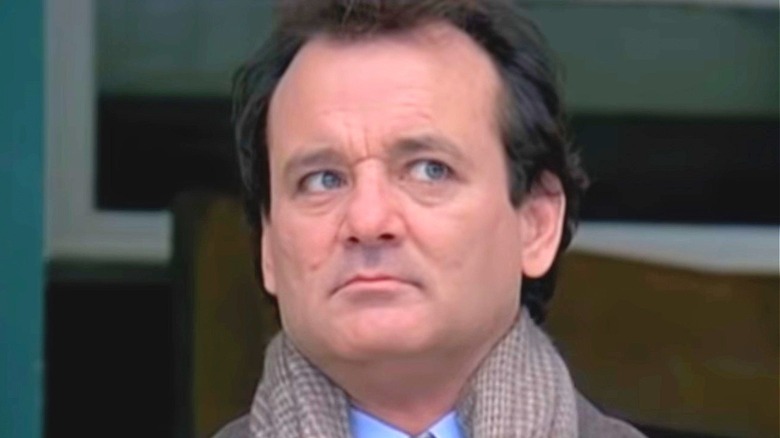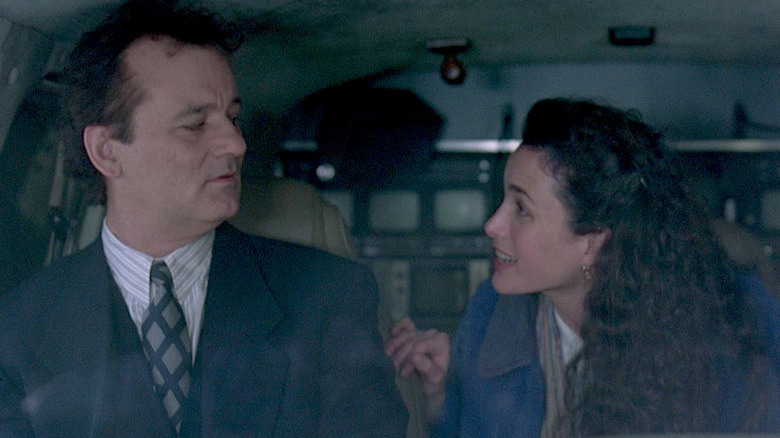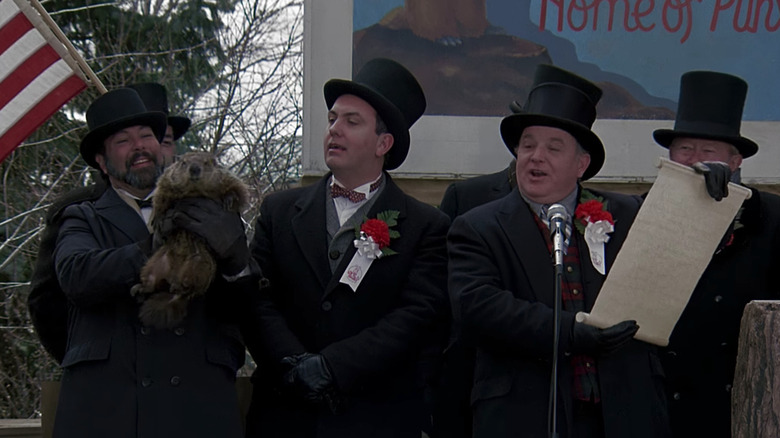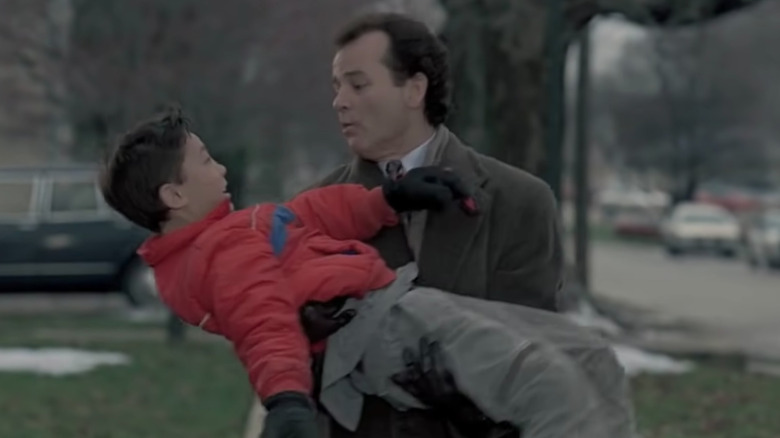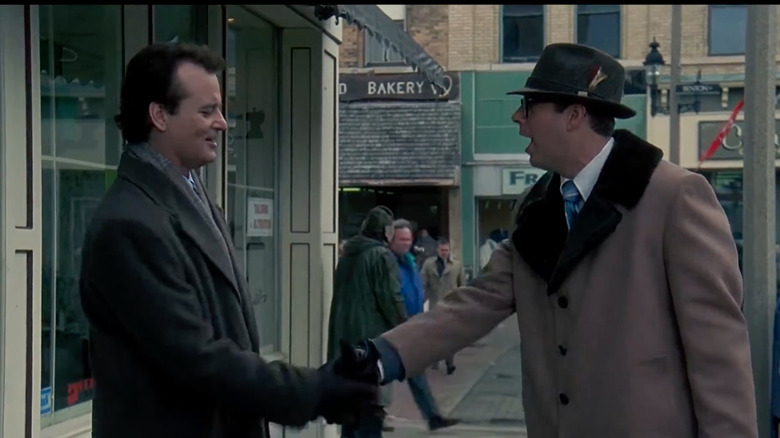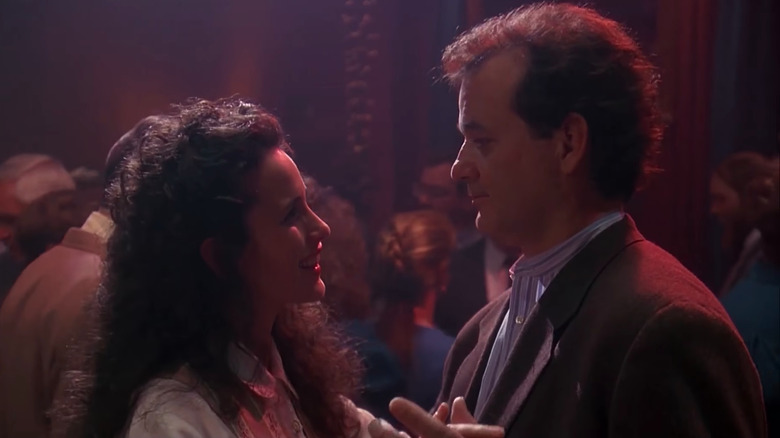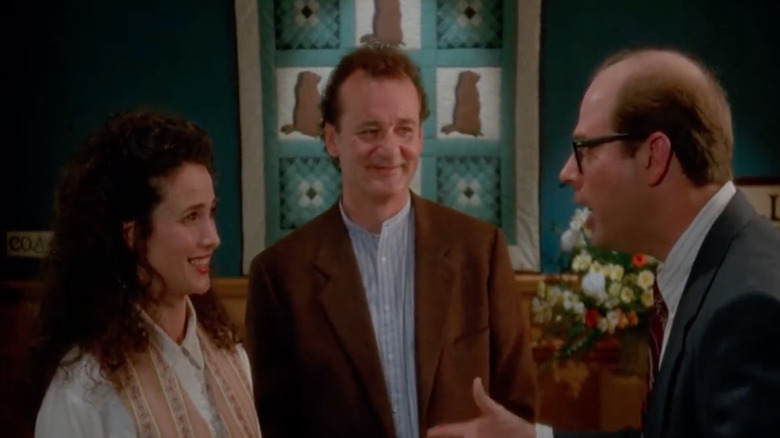The Ending Of Groundhog Day Explained
The 1993 Harold Ramis comedy "Groundhog Day" may not have spawned the hero-caught-in-a-time-loop genre, but it certainly prodded it to life. To this day, the film carries a 97% rating from critics on Rotten Tomatoes. Bill Slowik of The Chicago Tribune calls it "the best movie ever made." It stars Bill Murray as Pittsburgh weather reporter Phil Connors and Andie McDowell as producer Rita Hanson, and features three perfectly played supporting characters: Larry the cameraman (Chris Elliott), Punxsutawney Mayor Buster Green (Brian Doyle-Murray), and Phil's old schoolmate Ned Ryerson (Stephen Tobolowsky).
After four straight years covering Groundhog Day festivities, Phil has nothing but contempt for the holiday and the Punxsutawney locals, telling Rita "they're hicks." But a blizzard strands the news team in town overnight, and Phil is trapped in a loop that keeps returning him to his bed and breakfast room as the clock hits 6 a.m. He exploits his predicament for every selfish purpose before finally learning to recognize, and eventually prioritize, the needs of others. In the process he falls in love with Rita, and on his umpteenth date with her — but still her first, with him — Phil tells her he is content, they kiss, and the spell is broken. The next morning he finally wakes up on February 3 and they presumably live happily ever after.
While it may seem like the kiss was what set Phil free, there are many hidden layers to the ending of "Groundhog Day."
Phil's actions in the movie's early stages are driven by his runaway ego
When we first meet him, Phil has one foot out the door of a job he feels is beneath his great talents. He is selfish, crass, and sexist, wordlessly passing by a man (Les Podewell) asking for money on the street and blowing off his old schoolmate Ned before greeting his young female producer at the beginning of their first full workday together by asking her if she slept okay without him.
Everything Phil does and says is driven by his enormous ego. When the storm — which he had predicted would pass by the area — traps them in Punxsutawney, he tells a state trooper "I make the weather" and a telephone operator that he is "a celebrity in an emergency." Phil's initial shock at being stuck in his worst waking nightmare momentarily tamps down his rudeness, but he is still obnoxious with hotel staff, Ned, and his coworkers until long after his confusion gives way to depression.
After spending a night in jail for a drunk driving crash, Phil is returned peacefully to bed and is convinced his actions have no consequences. His first inclinations are unsurprisingly shallow and self-serving: he lives out the seven deadly sins – binging on food and sex, greeting Ned with a punch in the face, and stealthily stealing a bag of cash from a clumsily guarded armored truck.
Later Phil turns his attention to getting to know Rita
Once resigned to life in his loop, Phil takes a sincere if still prurient interest in Rita and dedicates his infinite supply of time to learning what she likes and molding himself into that form. But he fails to acquire — or even seek — any self-knowledge, so despite his dedication to the things most dear to her she rejects his romantic advances over and over, sending Phil into a suicidal depression. He kidnaps his groundhog namesake and tries to kill them both by driving into a rock quarry, but wakes up intact again that same morning — again. After a slew of further attempts to break the loop by offing himself, Phil is able to convince a skeptical Rita of his plight, telling her "I've killed myself so many times I don't even exist anymore."
After they spend a romantic day and evening together, Rita dozes off and Phil has a moment of unprecedented vulnerability and sincerity. But the destruction of his ego and the emptying of his soul aren't enough to free him, and he wakes up once again on February 2. It is, though, a different Phil that rises the morning after his ego death. He hands over a wad of cash to the same man he has bypassed so many times, brings coffee and pastries to his co-workers, and even asks Larry about his kids.
Phil Connors has a lot to learn from religious scholars
But he still rejects Ned, although this time it's with a lingering creepy hug instead of a punch to the face. Despite his newfound mission to do good in the world, in this one interaction Phil is motivated solely and powerfully by his desire to avoid being annoyed by his old Case Western High classmate. Eventually Phil's day becomes filled with acts of service to others: catching a boy (Shaun Chaiyabhat) falling from a tree, changing a tire for three townspeople (Barbara Ann Grimes, Ann Heekin, and Lucina Paquet), and saving the Mayor with the Heimlich maneuver. In the movie's most moving sequence, he repeatedly tries and fails to save the life of the old man he had ignored until recently.
But despite living many Groundhog Days in service to others — some theorize that he was stuck in Punxsutawney for as long as 10,000 years, according to Mashable – Phil's motives are still less than pure. Even after he outgrows his self-destructive and suicidal phases, he is fueled by his romantic interest in Rita, then by the hope he can break free from the loop, and finally by the desire to turn his personal hell into a more livable place by enriching himself: learning to play the piano and carve ice sculptures and delivering a moving on-air report on what a long winter means to him.
Religious scholars have found their own lessons paralleled by the message of Groundhog Day
Religious theorists have found meaning in the film. Director Harold Ramis told The New York Times that he has heard parallels to "Groundhog Day" drawn by leaders of Christian, Jewish, and Buddhist congregations. Rabbi Pini Dunner makes firm connections between the film's arc and a traditional Passover, saying that both an annual Passover Seder and Phil's never-ending Groundhog Day are a series of consistent pre-scripted events, and Phil (and anyone celebrating Passover) can similarly define their own progress by how they react to those events.
"That is the wonder of Judaism — it is Groundhog Day, the same, and yet every day is different, allowing us to hone it and perfect it, while at the same time preserve it and cherish it as our authentic heritage and tradition," says Dunner. Phil's day also has an indelible framework to it: "I Got You, Babe" playing on the radio when the alarm goes off, his encounter with Ned, the snowstorm, etc., and he similarly has free will within that structure to find his own redemptive path.
Buddhist scholar Dr. Angela Zito said that Phil's continual death and rebirth and repeated chances to make things right in his universe mirror the repeating cycle known as samsara, and that "Bill Murray is the bodhisattva" who is "released back into the world to save it" (also per The New York Times). Teachers of Falun Gong have even used the movie to directly illustrate the need to learn from one's mistakes before spiritual progress can be made.
Phil finally breaks free by performing a truly and wholly unselfish act
Mental health care professionals also find meaning in Phil's journey. Ramis told the New York Times that numerous psychiatrists have mentioned to him that they typically work with people stuck in their own loops of "reliving the same old patterns over and over again until we gain the right to free ourselves," and script writer Danny Rubin told Psychology Today that creators, in their words, "actually took Elisabeth Kübler-Ross as a model — her five stages of death and dying — and we used that as a template for Bill Murray's progress." In his book "The Magic of Groundhog Day," self-help author Paul Hannam uses Phil's hard-learned lessons to show people how to "transform a mundane day into a magical day by simply changing your attitudes."
What the world's oldest and largest religions and modern psychology all share is the requirement that Phil learn to behave in a truly selfless manner before he can be freed. The litmus test for his motivation is the interaction he keeps rejecting — his reunion with his old school "friend" Needlenose Ned. On Phil's final Groundhog Day, Rita wins him at the Groundhog Festival auction and on their way out of the hall they run into Ned, who gleefully informs Rita that after not seeing him for 20 years, Phil bought a robust insurance package from him earlier that day: "whole life, term, uniflex, fire, theft, auto, dental, health — with the optional death and dismemberment plan — [and] water damage."
Religious theorists would agree that Phil's insurance purchase releases him
A man living a life with no consequences, as Phil had been for quite some time, has no need for insurance of any kind — Phil apparently buys every kind. This is the only one of Phil's seemingly altruistic acts that was solely of benefit to someone else, and the only exercise that could free him. Rabbi Dunner and Dr. Zito would say that Phil's day, after being carefully honed over thousands of repetitions, finally reached perfection or nirvana with his insurance purchase. Hannam would point to Phil's capitulation to Ned's sales pitch as the moment his attitudes shifted enough to free his soul. There's even a bit of Christian symbolism in the film's climactic moment, with Phil's head framed by a cross of groundhogs and a halo of light as Ned shows his gratitude.
While musical cues and a strange look from Phil suggest that his kiss with Rita is what breaks the spell, that is simply the moment he realizes he has been released from the loop. He was imprisoned because of his egotistical ways, and could only be freed when he finally performed a purely unselfish act. He put the key in the lock by purchasing insurance from Ned, Ned opened the door for him in front of the groundhog cross art, and Phil walked through it when he kissed Rita.
